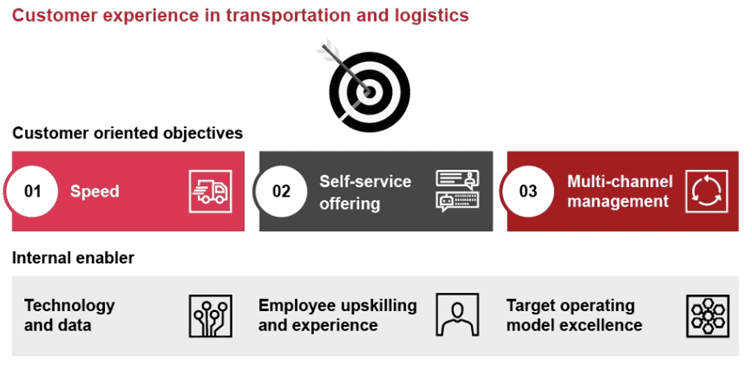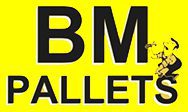Delivering the best customer experience, and how TMS software can help
Customer demand for speed and transparency of their transport orders has grown significantly in recent times. The shift in consumer habits away from the high street to online shopping since COVID, has resulted in shippers expecting a more consumer-like experience from their haulage partners. It’s no longer ‘ok’ just to let shippers know that their delivery will arrive. They now expect to receive it by a certain time, on a particular day, and stay closely informed throughout the entirety of the journey.
A recent report from PwC published November 2023, highlighted logistics companies “must provide the fundamental “seven Rs” to customers: the right product(s) must reach the right recipient at the right level of quality, at the right time, in the right quantity, with the right information, and at the right price.
The report highlights B2B expectations around usability and responsiveness have risen, and an additional eighth “R” has joined the B2B list: the right experience.
How can transport management solutions help hauliers to provide the 7 R’s and right experience? What does a leading customer experience look like?
PWC says, “For transport and logistics companies, it starts with potential customers reaching out to them, receiving quotes, followed by a seamless customer onboarding process. Once they are operationally working together, it means more timely and efficient responses to enquiries, best-in-class operational execution, real-time problem solving, fast complaints and claims management, and efficient billing processes.”
There are three customer-oriented objectives and three internal enablers that companies in the transport and logistics sector should focus on, say PWC. It’s these three customer-focused objectives and enablers that will help operators deliver a better experience and win and retain customers:
- Speed – Today’s customers want everything, now. They expect information relating to their shipment to be available and expect problems to be resolved in a timely manner.
- Self-service – Convenience is everything to the customer, with self-service bookings and automated information transfer between systems, ease-of-use and always-on services, the new norm.
- Multi-channel Management – Keeping customers informed throughout the journey is key, and the ability for customers to provide effective forms of communication at key touchpoints as situations change, will drive greater customer satisfaction.

Delivering the 7 Rs: the right products, to the right recipient, at the right quality, the right quantity, with the right information, to the right place and the right price
A combination of details come together in the TMS to help hauliers to ensure the right products are delivered, in the right level of quality, quantity, and to the right recipient, in the right place.
The haulier is informed of what’s included in the consignment when the order first arrives in the TMS ready for the traffic office to plan. From there the job is planned, and allocated to the correct vehicle and driver.
If a consignment is being routed onto another vehicle, cross docking keeps track, ensuring it finds its way onto the correct vehicle and arrives at the right destination. At the point of delivery, the driver can log conformance and any amendments to the consignment. With notes and supporting images taken to ensure the right quality is delivered.
The right information flows all the way through the system to the driver, ensuring they are equipped with all the information they need about the consignment.
Rate schedules per customer ensure jobs are correctly priced, and any amendments made to the job at the point of delivery are accurately reflected in the final invoice.
How can a TMS help hauliers to provide the best experience?
Seamless onboarding process
Integration with customer systems ensures the timely and efficient exchange of data, negating any need for manual input for both the customer and the haulier. Speedily transferring and updating information enables both parties to benefit from accurate, real-time data, and quick and easy job creation.
Automated processes
A TMS like Mandata has evolved to automate repetitive tasks, and to take the complexity out of processes, minimising errors and duplication, and saving time. The right TMS can automatically price work for hauliers using auto rate schedules. They add the greatest value to a haulier, by quickly and accurately pricing work. It’s a critical task which can typically take many people, many hours, reducing the time taken to get jobs to the traffic planner and ensuring the right rate is charged consistently for every job.
Meeting customer needs
Knowing and understanding the customer and ensuring customer’s individual needs are met, is a challenge. However, with the right TMS, insights into your customers and their specific service needs can be captured within the TMS, ensuring factors such as on-site restrictions, timeframes etc will be considered at the planning stage. Planners will have any details relating to the customer job, to balance both the needs of the customer with the needs of the haulier as they plan the work.
With a TMS offering pre-plan ETAs, planners can take customer needs into account when planning work. With Mandata Enterprise TMS, ETAs can be calculated for both the start and endpoint of the stage planned,
By being able to see this information at the planning stage, it allows more informed decisions to be made, if it’s likely that a job being planned will be late. Can we start the driver earlier? Is it possible to rearrange the load order? Can we call the collection or delivery point the day before to re-arrange our onsite time, or is it best to move a job to another load to achieve onsite time requirements?
With this approach, hauliers can avoid overcommitting their fleet by creating realistic plans they know they can achieve, whilst meeting customer expectations.
End-to-End Self-service technology
Once an order is placed, and with the haulier, notifications can be set up to keep customers informed at key touchpoints. With access to an online booking portal, real-time updates, and with a track and trace app, the customer can stay informed throughout the life cycle of a job, minimising calls into the haulier for ETAs.
Big data usage and continuous data exchange
Seamless integration with 3rd-party systems ensures customers and their haulage partners are using the latest information available, with data centralised in the TMS. Hauliers can manage their operations more effectively, with access to all the information they need.
Visibility during live job execution
Customers can be kept informed though real-time monitoring of consignments, drivers and vehicles. Information such as live tracking can be automatically shared with customers, fully keeping them in the loop when it comes to their deliveries.
Keep customers updated with job status updates
Without technology, this is a very difficult task. TMS platforms provide customers and traffic planners with real-time job status updates, not only keeping the customer in the loop with their order, but also keeping the transport team up-to-date.
Customers can be provided with job status alerts, notifying them of where their deliveries are throughout the collection/delivery process, with ETAs also helping to provide greater visibility and to manage delivery expectations.
Real-time problem solving
With live visibility of operations, planners can see if jobs are going awry and address issues proactively to manage exceptions before they affect the customer.
Allow customers to self-serve
TMS users also benefit through integrated customer portals. This module allows customers to enter orders themselves, with this information feeds updates the TMS. This saves the transport team valuable time, allowing their customers to access the latest job status updates. The portal also holds historic job information within the Cloud, such as PODs and invoices, which is accessible to customers 24/7, and accessible anywhere with an internet connection.
Efficient billing processes
Drivers can make job amendments at the point of collection or delivery, and updates are fed back through to the job in the TMS, ensuring accurate invoices are being produced and far less susceptible to customer disputes.
With invoices being generated by the TMS and emailed together with the relevant job documentation, customers receive all the necessary information they need, and they can receive this quickly after the job is completed.
There is now no need for lengthy delays in matching and scanning paperwork before invoices and PODs are created and sent to the customer. This process can be very quickly completed, speeding up processes for both haulier and customer.
Fast complaints and claims management
With all the relevant information held for each customer, in the TMS, and supporting information such as photos, driver notes and amendments, time-stamped signatures and geo-location information all on the documents required, a TMS can support the haulier’s ability to handle complaints and disputes more effectively.
Safer, greener transport
There is a growing expectation for transport partners to demonstrate how they’re actively reducing their operations’ impact on the environment.
Through tools such as telematics, operators can show how they are actively monitoring and training their driving community to improve driver and vehicle performance and improve positive driving.
Other tools within the TMS help hauliers to optimise efficiency, as well as reducing their carbon footprint. With Map Based planning, transport planners can visualise routes, and identify opportunities to reduce empty running (or ‘dead miles’) within their planned haulage work. These amendments help operators to make the most out of every mile travelled, eliminating needless miles that contribute to their carbon footprint.
Bring all customer data together
Mandata offers a full suite of integrated software solutions, meaning that data captured at the beginning of the customer order, and any subsequent changes, are tracked and logged through the system. This is also true for 3rd party platforms. Bringing key details into the TMS, gives hauliers all the information they need in one place, and avoids having to refer to multiple systems to find one answer.
Ensure transparency
Giving customers the visibility they need, even if things aren’t going to plan, is essential.
Through live status updates, hauliers can pre-warn customers of any potential issues or delays. ETAs will be updated automatically, and they will have a true and accurate picture of the progress of their orders.
What a Mandata TMS offers haulage operators
2024 marks a significant milestone for Mandata, as the company celebrates 50 years of partnership with transport and haulage operators.
For half a century, Mandata has been at the forefront of delivering market-leading transport management software (TMS), adapting and evolving to help customers meet shipper’s changing needs.
By using a Mandata TMS, haulage operators have been able to improve efficiency and communications with their team and deliver more value by saving customer’s time and effort, whilst keeping customers informed, with the help of its integrated cloud and mobile technology.
To keep updated with the latest news, trends and industry insights, sign up to our newsletter below.

Proof of delivery is digital, time-stamped and with the GPS location, which all makes answering customer queries much quicker.
